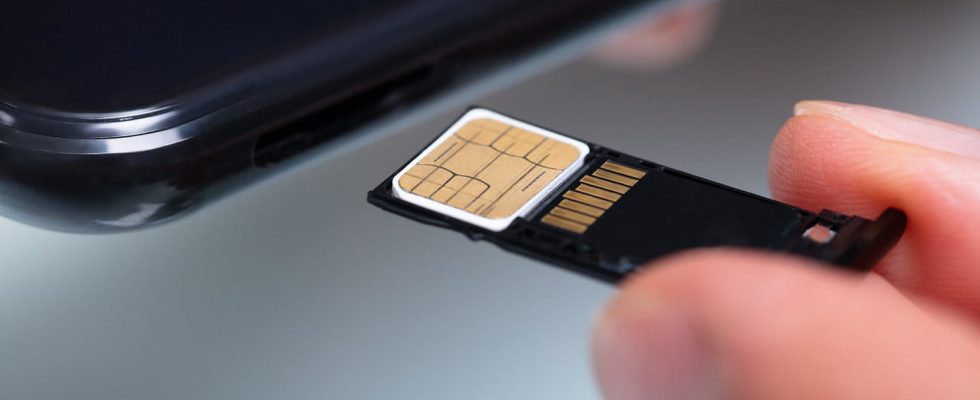While the eSIM is beginning to become popular on smartphones, a new replacement for the traditional traditional SIM card is already announced: the iSIM, an equivalent directly integrated into the phone chip.
You will have to get used to seeing smartphones without any drawer or SIM slot, this famous little electronic card associated with a package, essential for communicating on a mobile network. And for good reason: for several years now, manufacturers and operators have been proposing to replace it with the eSIM (contraction of Embedded-SIM, for integrated SIM or embedded SIM in French), an equivalent taking place in a dedicated chip in the smartphone. An evolution largely linked to a problem of space. And which will become even more pronounced in the coming years with the arrival of iSIM, the ultimate technology to replace the classic SIM card…
eSIM: a SIM card integrated into the smartphone
In fact, the space being in essence counted in a smartphone, the manufacturers seek to miniaturize all the elements – except the screen! – in order to integrate a maximum of components and sensors as well as ever larger batteries while preventing the devices from becoming too massive. And the SIM card does not escape this endless embitterment cure! Because even if it has become smaller and smaller over time – passing from SIM format to micro SIM then to nano SIM -, it takes up all the more space as it requires housing in the form of a slot or drawer. Hence the gradual generalization of the eSIM, this miniaturized version of the traditional SIM card directly soldered to the motherboard which allows manufacturers to do without the SIM card drawer – and therefore to save space for the components – which also allows operators to modify the information it contains more easily and remotely (see our practical sheet).
The eSIM has been supported by many manufacturers for several years, especially for high-end smartphones. Apple has even taken a step forward since, in the United States, the iPhone 14 no longer has a physical SIM card drawer, which forces their users to adopt the eSIM. And devices running Android could soon follow the same path! In effect, Google announced at MWC 2023 – held in early March – a new eSIM transfer function on its operating system. Better support for the eSIM will therefore facilitate its use and should encourage the adoption of the technology. But its successor already seems to be entering the scene, since Qualcomm and Thales launched an improved version at the end of February, called iSIM.
Google wants to make it easier to transfer an eSIM from one device to another, based on security standards from the GSMA (telecommunications industry association) and CSA (Conseil supérieur de l’audiovisuel) . Later in the year, “We will offer a new eSIM transfer feature for Android, which will allow users to quickly and securely transfer their mobile plan to a new device, without having to swap out a physical SIM card”, announces the digital giant. The German operator Deutsche Telekom will be the first to adopt this new function of the ecosystem. The firm has not given more details for the moment, but this announcement marks an important step towards the replacement of physical SIM cards by eSIMs.
iSIM: a SIM card integrated into the processor
However, the eSIM already seems to have found a successor with the iSIM (Integrated Subscriber Identification Module, or integrated subscription identification module in French). This technology has the same functioning as the eSIM but differs in its design. Indeed, the eSIM is a separate component that is soldered on the motherboard of the smartphone. On the other hand, the iSIM is directly integrated into the SoC – the main chip, which notably integrates the CPU and the GPU. As a result, it allows the manufacturer to save space, and therefore to integrate a larger battery or to offer a thinner smartphone, and to reduce construction and logistics costs. Not to mention that it can directly benefit from the chip in which it is integrated!
The iSIM card project has been underway for several years now, but it was during the MWC that Qualcomm and Thales announced at the end of February having developed and integrated an iSIM into the Snapdragon 8 gen 2 processor, which now equips most high-end devices from 2023, such as the Samsung Galaxy S23 or the Xiaomi 13. Better still: iSIM has obtained GSMA certification, which certifies that in terms of security and flexibility for users, iSIM offers the same advantages and guarantees as eSIM. To issue this certification, the organization focuses on three points: the iSIM must be as resistant to sophisticated attacks as the current eSIM chip; the sensitive elements loaded onto them by chip and smartphone manufacturers in their factories must be protected to avoid any compromise during manufacture; the iSIM must be compatible with the standards of the remote activation services of the operators.
“Alongside the increasingly popular eSIM, Thales’ 5G iSIM offers device manufacturers and mobile operators even greater freedom. This allows them to offer their customers wireless, effortless connectivity and an ever more interesting and accessible range of services.“, explains Guillaume Lafaix, vice-president of integrated solutions at Thales. Thus, the user can have several subscriptions at the same time – a professional and a personal, or for two countries for example. users, operators and manufacturers, so its generalization should be done little by little. study by Kaleido Intelligence, iSIM could take 19% of eSIM shipments in 2027, or 300 million units. And the SIM card slot market is colossal: in France alone, as of December 31, 2022, there were some 82 million conventional SIM cards in circulation.

